09:44, 52041 view Each device from a smartphone or tablet Nexus series very often and are actively discussing. Typically, this series includes models that can not only offer the most advanced version of Android, but at the same time to please-value characteristics. This year there was the Nexus 6 and tablet Nexus 9. The latter immediately replaced the two models: Nexus 7 and 10. If the 10-inch version of the special popularity in Russia is not received, the more compact tablets like many, that explained their attractive price and characteristics.
• Print

responsible for the release of a new tablet was the HTC, the Taiwanese company has earned a reputation for interesting devices in terms of design. This was the first manufacturer who has produced all of the device series Nexus, so now the baton came back. The tablet will be available in three variants of color execution, he was a very powerful processor NVIDIA Tegra K1 and most advanced version of Android to date.

Specifications
- OS: Android 5.0 Lollipop
- Network: GSM 850/900/1800/1900, HSDPA 850/900/1700/1900/2100, LTE 800/850/900/1700/1800/1900/2100/2600, nanoSIM
- Processor: NVIDIA Tegra K1, 2 cores, 2.3GHz
- Graphics: Kepler DX1
- Built-in memory: 16 GB or 32
- RAM: 2 GB
- Screen: QXGA 1536h2048, 8.9 ”, 281 ppi, IPS, Gorilla Glass 3
- Network: Wi-Fi 802.11ac, Wi-Fi Direct, DLNA, Bluetooth 4.1
- Navigation: A-GPS, GLONASS
- Camera: 8 MP, autofocus, flash, video recording 1080p @ 30fps, stereo sound. 1.6 megapixel front camera, video recording 720p
- Sound: Stereo BoomSound
- Connectors: 3.5 mm, microUSB
- Dimensions: 228,2h153,7h7,9 mm, weight 425 g
- Battery: 6700 mAh
- Price: from $ 499 in the US, get the best price possible in Russia in the store BoomMarket.ru

Design and assembly
For the production of the smartphone HTC, the Taiwanese company has had the reputation of the brand, which is able to please the design to create something beautiful and spectacular. In the case of the Nexus 9 it is not so. It looks great and stretched the Nexus 7, recalling last year’s model from ASUS, only with a different aspect ratio. On the one hand, from the perspective of Google, logic is clear: we need continuity products. But at the same time those who love and remember their HTC tablet Flyer, look at the Nexus 9 perplexity, nothing to do with a nice tablet or smartphone beautiful modern Taiwanese brand is not here.


The plate is not small, the size of it is between the iPad Mini and the iPad Air, if you take the tablets Apple as the benchmark in its class. If you look at a series of 7-inch Nexus, then NEW turns noticeably larger compact device. This is logical, because the screen size has increased by almost 2 inches. So for those who are critical mobility and moderate size, it is not the best option. If before Google offers a choice of options for different formats, now offered only one standard. This model immediately replace the plates with 7- and 10-inch screens.


weighty device it’s best to keep both hands and other usage scenarios seem unlikely gadget. For comparison, iPad Air 2 with a 9.7-inch screen weighs 437 g, and the Nexus 8 9 ” – 425 g, which is not too small, given the difference in screen sizes and the materials used. The difference in thickness is even more impressive is not in favor of HTC: 6,1 mm to 7.9 mm. The body can not boast of a minimum thickness as it is now fashionable.



The back surface is made of plastic softach, it is the same as that of the Nexus 7 is the second generation. It does not scratch, but dirty at an alarming rate, we have to be regularly cleaned enclosure. Sides in the plate made of metal, it is especially easy to see in the cold season, when bear Nexus 9 on the street.


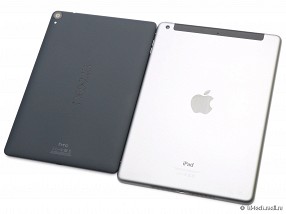
At the center of the back of the body can be felt vyshtampovki with the model name. The very smooth surface, sides slightly rounded towards the ends of the plate. In the upper left corner is visibly out all the camera lens by which there is a small outbreak.




Port Headphone imposed on the top end, microUSB connector is located at the bottom. power button and volume control on the right side, but they are uncomfortable, quite flat and click them uncomfortable. But do not forget about the management of gestures when tapping the screen, you can unlock the tablet, thereby bypassing the restriction associated with the awkward button.


The tablet got a pair of speakers in the style of HTC. They are located on the front panel and are two symmetrically arranged slots on top and bottom. I think that over time, the holes can easily become clogged with debris, or dust.


Build tablet disappointed, it creaks and crunches, it is clearly not enough margin of safety. To see such a low build quality in a device of this level is very strange, the nearest competitor, and there is no hint of such behavior. HTC obviously should pay more attention to the quality of manufacture of its products.
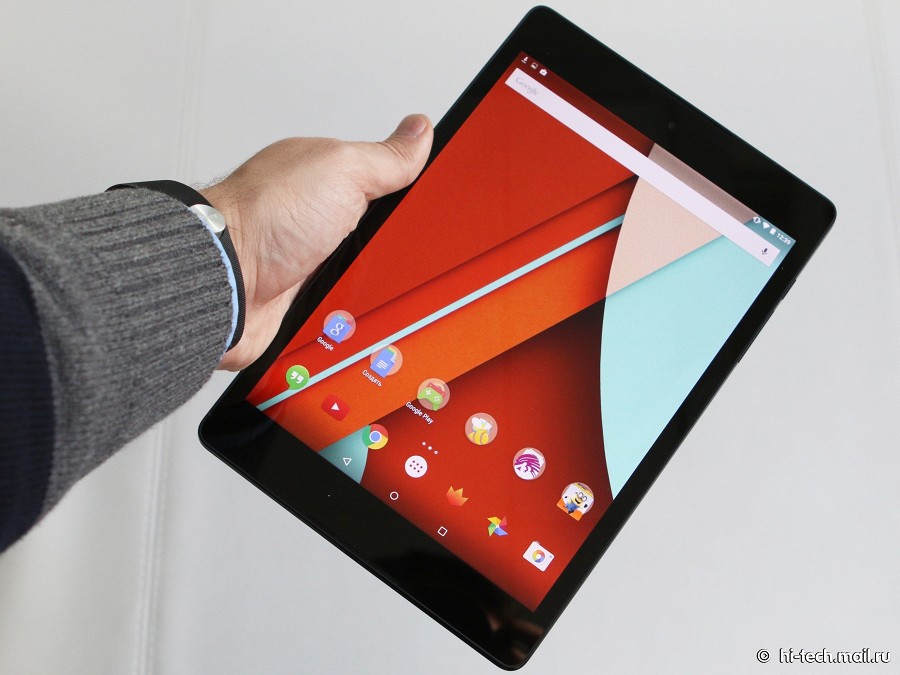
Screen
Nexus 9 offers atypical for tablets of this series of Android-devices aspect ratio of 4: 3. It has exactly the same resolution as that of the iPad, it is 1536h2048 pixels, but reduced by diagonal here we obtain a higher density of pixels than the competitor. At Nexus we get 9 281 ppi versus 264 models from Apple. Used IPS-matrix, which is traditionally characterized by large angles.

Despite the nominally high quality, practical screen tablet disappointed. Uneven and punched the side lights, air space, clearly visible glare in the complex does not give the feeling of owning a device with excellent display. If Previously, it has been forgiven, the price could justify, now playing with the iPad on an equal footing, would like to see a decent quality display and a competitor.

Detailed screen testing conducted by our expert Mikhail Kuznetsov:
In the tablet Nexus 9 uses an LCD matrix 8.9-inch IPS. High resolution 1536×2048 pixel density provides 281 ppi, it is enough to provide a clear image. Of course, if you look closely, at the fine print, you can see the typical artifacts. But with his usual distance is almost imperceptible.
The maximum brightness was 442 cd / m 2 , its stock is sufficient for most conditions. Contrast Ratio – 1000: 1, the usual level for most of the IPS. Anti-glare properties are good enough, even though the substrate at a certain angle of the screen gives specific tide. Wide viewing angles as usual for IPS: color angled slightly distorted, but falls contrast. Under the very large angle can be seen as LED lights “breaks” on the edge of the screen. This show, however, does not interfere with the normal use.
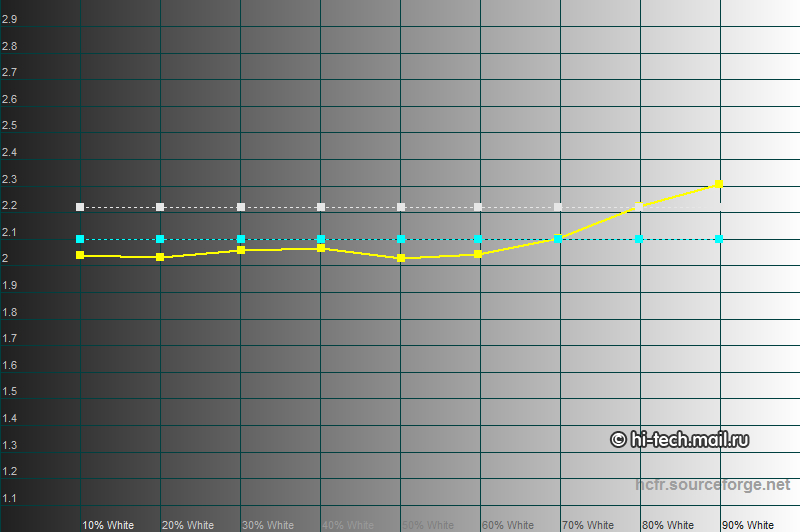
The average gamma understated – 2.09. Image lightens somewhat relative to the original and becomes more “faded” than at the optimal range of 2.2. But if we talk about it a comfortable room lighting. And on the street may be appropriate scale down.

The average color temperature – about 7000K.

Color Balance acceptable level, but the blue component in excess. The average error Delta E on a scale of gray – 6,83.

The color gamut of the display is very close to the standard sRGB. The palette has the best hue and saturation.
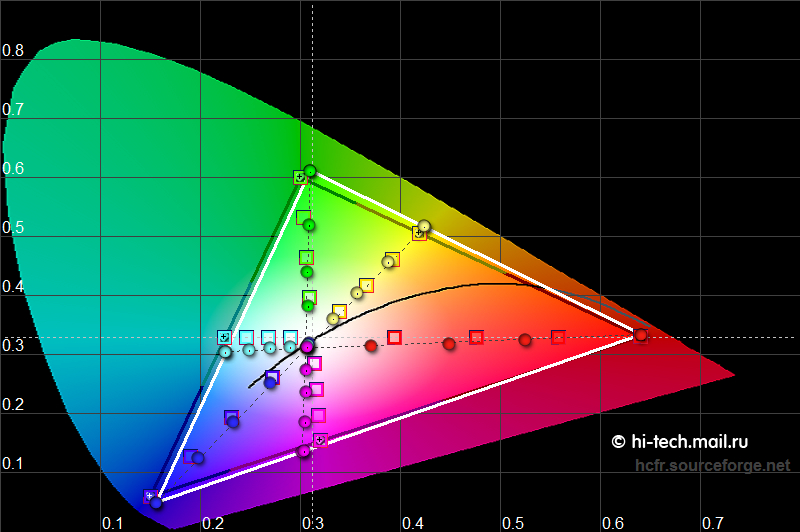
The intermediate gradations are somewhat displaced due to the bluish impurities.

Overall color on the 24 templates ColorChecker gives an average error of Delta E value of 4.53. Distortions are present everywhere, but, generally, they are not too large.
In summary, we can say that the Nexus 9 is applied fairly standard LCD IPS, main feature of which is a high resolution (including tablets) and good brightness characteristics. Color reproduction is acceptable, the flaws will not be very evident. However, some striking advantages compared to other tablets equipped with matrices IPS, was not found. The bottom screen Nexus 9 even slightly inferior to the Nexus 7 in quality.
Performance
Tablet running the latest version of Android, filling he is also very modern. This set processor NVIDIA Tegra K1. By the way, the chip from NVIDIA has already been used in the 7-inch tablet Nexus first generation, have now decided to go back to this development. This time is used most productive solution on the market in the face of NVIDIA Tegra K1. In the tablet with dual-core 64-bit processor great potential for the future, yet to reveal the possibilities K1 will not work. Or the device may be called a very powerful tablet. Although not the most efficient on the market, it is inferior to the same second-generation iPad Air in some tests.



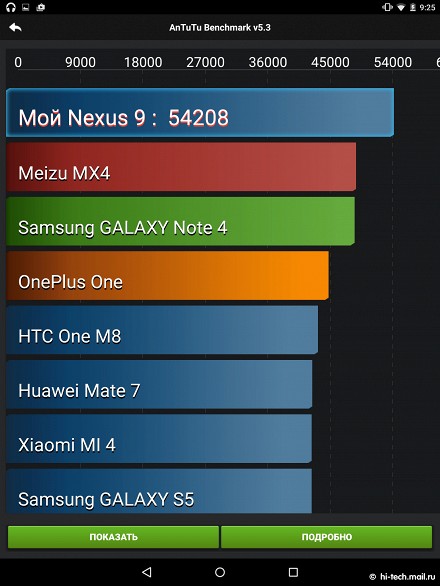








Processor NVIDIA Tegra K1 is very powerful, but the problems with the games it does not save. Some programs the device simply does not establish, let them not very much at first glance, but, nevertheless, remains an unpleasant aftertaste. Not all games support this resolution and aspect ratio, but there is hope that the developers optimize their programs. And yes, the old problem with a resolution of Android is still in force, when instead of high-resolution images in the game we get a HD, which negates the benefits of the screen.



In the games tablet gets very hot, even when performing simple tasks like browsing the Internet is still the back panel becomes too warm. It’s obviously there are problems with the optimization of the filling, and we already tested tablet Tegra K1 earlier, there was no such problems. Apparently, HTC have not been able to optimize the filling, using its potential.




No comments:
Post a Comment